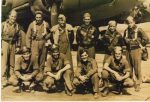
(Standing:Butterfield, Festa, Thomas, Menaul, Buonarobo, McClendon.
Kneeling: Francis, Dodge, Chandler, Becker)
The ten men in this picture assembled in May of 1943 at Ephrata Army Air Base, Washington, a place of which Jimmy-Junior wrote in disgust, “They have me living in a tent, out in somebody’s cow pasture. When we get into a crew, we move into hutments that are bigger than a doghouse, but smaller than a garage. I am the official ‘sound-the-alarm-er’ in case of rain. There is a rip in the canvas over my head, so I will be the first to know – it’s getting dark now and somebody forgot to put electric lights in this tent so I guess this is all I can write.” Two weeks later, he wrote, “As of this morning I am head armorer-gunner of crew #30. Crew #30 isn’t much to get excited about though, as all we have besides myself are the second armorer-gunner and the bombardier. I’m going to insist on a pilot before I do much.” A week later: “Our crew is changed around considerable. We lost everyone we had, but now we have a pilot, copilot and myself, which is much more practical than before . . . We fly today for the first time. Didn’t do much of anything but land and take off. After the third time I lost interest and slept most of the time.”
An observant young man with an unexpectedly sardonic sense of humor, born and raised in Pasadena, he had gone to trade school and left a job in the lithography department of the Los Angeles Times. Firmly convinced of all the then-forty-eight states there was only one good one, he was pleased that two other Californians were assigned to Crew #30: Lt. John Chandler, the co-pilot, was from Vallejo, and waist-gunner Sgt. Robert Thomas from Burbank. Both were married, and Mrs. Chandler was expecting a baby. True to the movie cliche, though, the rest of the crew was from all over: pilot and A/C commander, Lt. Sherman Dodge— also newly married— from Boston; bombardier Lt. James Becker from Kennet Square, Pennsylvania; flight engineer SSgt. James Festa, from Brooklyn; Sgt Louis Buonarobo, the ball-turret gunner (notably shorter than the other crewmembers) from the Bronx; navigator Lt. Frank Francis of El Paso, Texas; radioman SSgt Douglas McLendon from Greenville Mississippi, and waist-gunner Sgt. Warren Butterfield from Salmon, Idaho.
By mid-June they had accumulated fifteen flying hours. “Yesterday we made what they call ‘dry runs’—that is, going thru the motions of bombing something and don’t: that way, we bombed the city of Wenatchee, blew up the school in Quincy, a couple of dams, bridges and just about everything else in sight . . . got a letter from George— he had his first airplane ride and wished now he was flying. He could have had my place the other day when we went up to 30,000 feet, It got down to 40 below and I had to forget my flying boots! We just got up there and then an oil line broke so we had to come down, which couldn’t have happened at a better time. My nose was running under my oxygen mask and freezing on my lip. Very annoying. We had a gunnery mission today; I had the tail guns. I think they are mine permanently. At least I hope so, as I like it . . . we shot at targets on the ground. . .”
In July they moved to Geiger Field, near Spokane, for continuing training and a series of long flights all over the northwest; “We are supposed to be very observing of everything we see in the way of military objectives, especially trains and railway yards. Then we get questioned all about it, just as if we were over Germany or some place. I guess I will have to give up sleeping on future flights . . the navigator is getting me a set of maps so I can be able to tell where we are at. He claims in the tail I have the best view— not that anyone is depending on me, but he wants two of us . . “
In late fall, they were assigned a new B-17F, promptly christened the “Lonesome Polecat” by Lt. Dodge. Following another month of training flights, they ferried it to England, where the aircraft went to the replacement depot, and the crew to Rougham airfield, near Bury St. Edmunds, where they were assigned to an aircraft there. They promptly re-christened it “Lonesome Polecat II” but James Festa lamented during one of our conversations, they didn’t have it long enough to paint an emblem on the nose. Jimmy-Junior sent a telegram on arrival to let the family know they had arrived safely. Four V-mail letters followed, the last dated the day before his first combat mission: He couldn’t make sense of the coinage, there wasn’t much to buy that wasn’t rationed, he was making money faster than he could spend it. He hoped to visit London, and he had bought a bicycle to get around the field.
(Next: Part 3— Schweinfurt)
